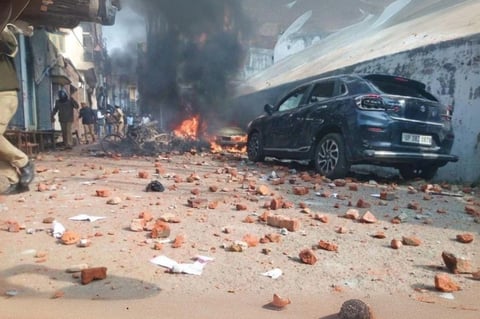SAMBHAL VIOLENCE
CURRENT AFFAIRS
Madan Mohan
1/22/20253 min read


Sambhal, a town in Uttar Pradesh, India, has been a significant focal point of historical and cultural debates. The recent violence on November 24, 2024, linked to the survey of the Shahi Jama Masjid, highlights longstanding tensions rooted in historical claims and disputes.
Historical Background
The Shahi Jama Masjid in Sambhal has been at the center of controversy due to claims that it was constructed in 1529 by Mughal emperor Babur after demolishing a temple dedicated to Hari Hara, a deity representing Lord Vishnu and Lord Shiva. This temple, known as Hari Har Mandir, held considerable importance in the region before its alleged destruction. The local community has contested the mosque’s origins for decades, with claims supported by historical records and local traditions.


Recent Developments
In November 2024, a Sambhal court directed the Archaeological Survey of India (ASI) to conduct a detailed survey of the Shahi Jama Masjid to ascertain its historical origins. The petition, filed by Mahant Rishi Raj and other community leaders, argued that the mosque was constructed over the remains of the Hari Har Mandir. This legal order followed years of demands from local organizations seeking clarity on the site’s history.
The survey began under tight security, with officials using ground-penetrating radar and other tools to examine the site’s foundations. Initial findings reportedly hinted at remnants of earlier structures beneath the mosque. However, these observations remain inconclusive pending a comprehensive report.
On November 24, as the survey entered its second phase, approximately 900 individuals gathered near the mosque in protest. Demonstrators claimed the survey was an attempt to incite communal discord. The situation deteriorated when violence broke out, involving stone-pelting, arson, and the use of firearms. Protesters set vehicles ablaze and attacked security personnel, leading to five fatalities and injuries to several others, including police officers.
Police Action and Arrests
In the aftermath of the violence, the Uttar Pradesh police launched a crackdown. By January 2025, a total of 60 individuals, including four women, had been arrested. Investigations revealed that a criminal network, led by Shariq Satha, a native of Uttar Pradesh now residing in Dubai was involved in orchestrating the unrest. Satha had connections to the underworld figure Dawood Ibrahim, suggesting external influences in the violence.
Despite these arrests, 89 suspects remain at large. The police have intensified their operations to track down the accused and prevent further escalation of tensions in the region.
Historical Patterns of Violence in Sambhal
The recent violence is part of a broader history of communal unrest in Sambhal. The town witnessed significant violence in 1978, during which over 183 Hindus lost their lives in a devastating pogrom. Such events underscore the deep-rooted communal sensitivities that have persisted for decades.
Conclusion
As of January 2025, the situation in Sambhal remains tense but under control. Authorities have imposed stringent security measures to maintain peace and ensure the safety of residents. The court-ordered survey of the Shahi Jama Masjid continues, with findings yet to be made public. The events in Sambhal reflect a proper orchestration of hate from one community, while the other suffer a historical injustice asking for the maintenance of community dynamics. The claims surrounding the Hari Hara Mandir and the Shahi Jama Masjid have significant implications for the local population and has widened the communal relations in India. From Somnath to Sambhal, the incidents are a prime example, how the history has been cruel on one side and even during the correctness phase, the same community is being attacked. As legal and investigative processes unfold, it is crucial for all stakeholders to prioritize dialogue and peace to prevent further violence and division.
